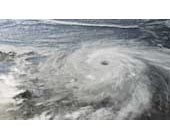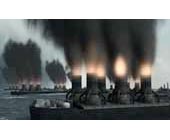


These theories are as wild as they are plausible. Usin both 3D near-photorealistic CG animation and stylized 2D animation, intercut with location demonstrations and lab testing, and with dramatic “ticking clock” scenes inside the National Hurricane Center, HOW TO STOP A HURRICANE is part human drama and part technological exploration, about people with dreams, who strive to confront and control one of Nature’s most dangerous creations.
There are two things you can say for sure about hurricanes. One: they are nature’s most destructive force, and two: another big one is on the way. In the aftermath of the incredible destruction on September 29, 2005, when Hurricane Katrina swerved away at the last minute from its target of New Orleans, imagine the devastation and loss of life when the Next Big One slams right into a major American city.
What, if anything, can the most technologically powerful nation in the history of civilization do to save itself? There are dozens of scientists, government researchers, inventors, and entrepreneurs who have theories of how to stop, weaken or divert hurricanes of mass destruction.
HOW TO STOP A HURRICANE visits Dr. Robert Knabb and his crew of the world’s top hurricane trackers at the National Hurricane Center Headquarters in Miami. So far their data doesn’t do anything to prevent hurricanes, only predict them. But that may be changing. We introduce seven theorists with widely different backgrounds and credentials who have developed a credible hurricane fighting plan.
Each of the seven scientists/inventors and their theories are profiled in turn, and “tested” against a hurricane using computer-generated animation and graphics. There is Ross Hoffman, of Atmospheric and Environmental Research, who believes that zapping the top of a hurricane with solar panels in space will cause it to change course.
Russian Meteorologist Vladamir Pudov wants to weaken hurricanes with a surface film on the ocean that will minimize the evaporation that feeds the monsters.
Phil Kithil, an inventor of remote-sensing devices, demonstrates his prototype ocean-going pump designed to neutralize hurricanes by bringing cold water from the depths to the surface.
Meteorologist William Gray, the world’s most famous hurricane expert, proposes burning petroleum on barges in the path of hurricanes to slow them down.
15-year-old Jason Stanton, Tulsa’s top science fair award-winner, devised a concept that would cool the ocean’s surface in the path of oncoming hurricanes by using liquid nitrogen.
Joe Golden has flown dozens of hurricane seeding flights probing the effects of seeding hurricanes with silver iodide in the hope of spurring convection of hurricane eye-walls and diminishing their force.
And Robert Dickerson, a senior weapons researcher with a strong track record in laser design, thinks it might be possible to alter the dynamics of hurricanes by providing ionized pathways for discharge of electrical charges on one side or the other of hurricanes using vertically launched ion exhaust rocketry or by high intensity laser pulses.
These theories are as wild as they are plausible. Using both 3D near-photorealistic CG animation and stylized 2D animation, intercut with location demonstrations and lab testing, and with dramatic “ticking clock” scenes inside the National Hurricane Center, HOW TO STOP A HURRICANE is part human drama and part technological exploration, about people with dreams, who strive to confront and control one of Nature’s most dangerous creations.
Length: 1 hour
Producers
Christopher Sumpton, Robin Benger
Director
Robin Benger
Writer
Robin Benger
2nd Unit Director and Researcher
Paul Webster
Narrator
Anne Marie McDonald
Cinematographer
Mike Grippo
Editor
Greg Hopen
Composers
Aaron Davis and John Lang
Format: HD
First Airing
October 18, 2007 on CBC’s “Doc Zone.”
